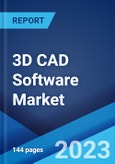Three-dimensional (3D) computer-aided design (CAD) software is replacing manual drafting for designing and technical documentation. It is widely utilized by designers, architects, engineers, and other professionals as it precisely represents and visualizes objects using a collection of points in 3D on a device. It also aids in improving accuracy for drawing precise dimensions and providing access to libraries of routinely used items, such as doors, windows, and manufacturing parts. Nowadays, market players are offering a broad portfolio of 3D CAD software programs to help users explore and share ideas, visualize concepts, and simulate designs before they are made.
3D CAD Software Market Trends:
The rising complexity of architectural structures, along with increasing investments in infrastructure, represents one of the key factors encouraging the adoption of 3D CAD software across the globe for creating functional, virtual prototypes and modifying minute details of a product, part, or assembly. It also facilitates and automates other aspects of product engineering, such as simulation testing, drawing and drafting, manufacturing, data management, and computer-generated animation. Apart from this, as 3D models can be rendered to create photo-realistic images for use in sales and marketing materials, the demand for 3D CAD software is escalating in enterprises around the world. Moreover, with the proliferation of home manufacturing technology like 3D printers and open-source projects, there is a rise in the need for accessible and free CAD software. Besides this, recent advances in 3D CAD software, including generative design, additive manufacturing, and enhanced reverse engineering capabilities, and the launch of cloud-based variants with remote features are anticipated to provide numerous growth opportunities to industry investors in the coming years.Key Market Segmentation:
The report provides an analysis of the key trends in each sub-segment of the global 3D CAD software market report, along with forecasts at the global, regional and country level from 2024-2032. Our report has categorized the market based on deployment and application.Breakup by Deployment:
Cloud-basedOn-premises
Breakup by Application:
Architecture, Engineering and Construction (AEC)Manufacturing
Automotive
Healthcare
Media and Entertainment
Others
Breakup by Region:
North AmericaUnited States
Canada
Asia-Pacific
China
Japan
India
South Korea
Australia
Indonesia
Others
Europe
Germany
France
United Kingdom
Italy
Spain
Russia
Others
Latin America
Brazil
Mexico
Others
Middle East and Africa
Competitive Landscape:
The competitive landscape of the industry has also been examined along with the profiles of the key players being Autodesk Inc., AVEVA Group plc, Bentley Systems Incorporated, Dassault Systemes SE, Hexagon AB, IronCAD LLC, PTC Inc., SCHOTT SYSTEME GmbH, Siemens AG, Trimble Inc. and ZWCAD Software Co. Ltd.Key Questions Answered in This Report
1. How big is the global 3D CAD software market?2. What is the expected growth rate of the global 3D CAD software market during 2024-2032?
3. What are the key factors driving the global 3D CAD software market?
4. What has been the impact of COVID-19 on the global 3D CAD software market?
5. What is the breakup of the global 3D CAD software market based on the deployment?
6. What is the breakup of the global 3D CAD software market based on the application?
7. What are the key regions in the global 3D CAD software market?
8. Who are the key players/companies in the global 3D CAD software market?
Table of Contents
Companies Mentioned
- Autodesk Inc.
- AVEVA Group plc
- Bentley Systems Incorporated
- Dassault Systemes SE
- Hexagon AB
- IronCAD LLC
- PTC Inc.
- SCHOTT SYSTEME GmbH
- Siemens AG
- Trimble Inc.
- ZWCAD Software Co. Ltd.
Methodology

LOADING...
Table Information
| Report Attribute | Details |
|---|---|
| No. of Pages | 142 |
| Published | July 2024 |
| Forecast Period | 2023 - 2032 |
| Estimated Market Value ( USD | $ 11.9 Billion |
| Forecasted Market Value ( USD | $ 19.5 Billion |
| Compound Annual Growth Rate | 5.6% |
| Regions Covered | Global |
| No. of Companies Mentioned | 11 |









